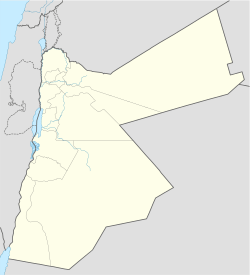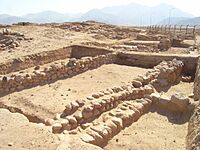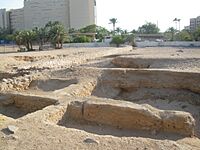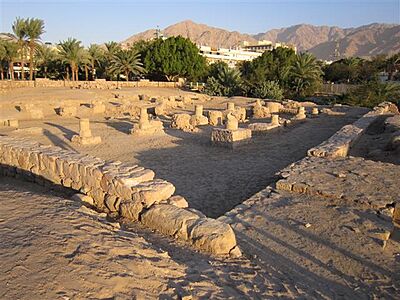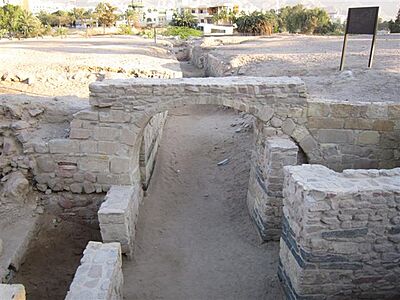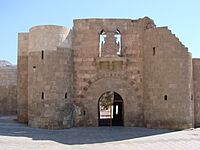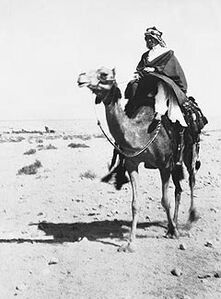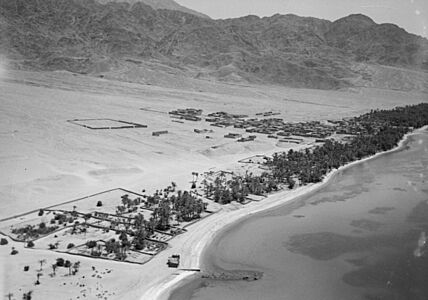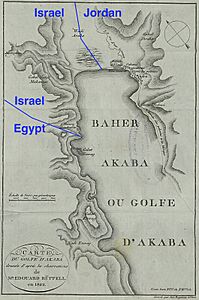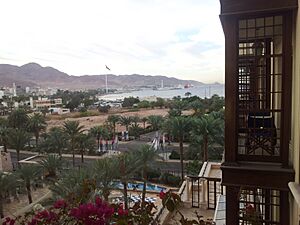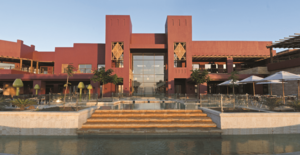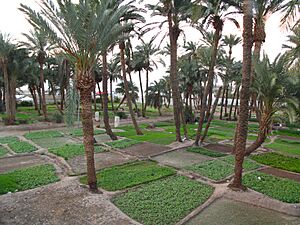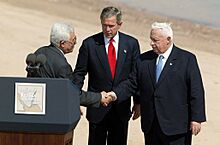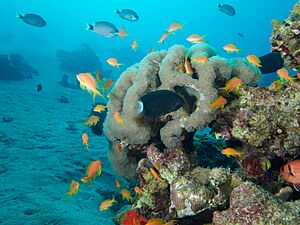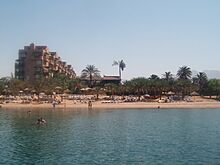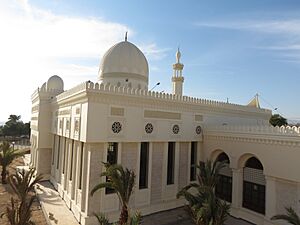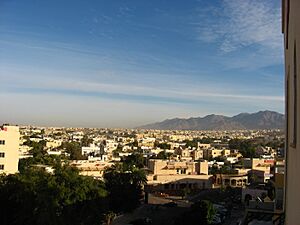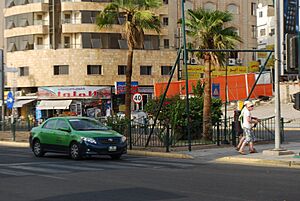Aqaba facts for kids
Quick facts for kids
Aqaba
الْعَقَبَة
|
|
|---|---|
|
City
|
|
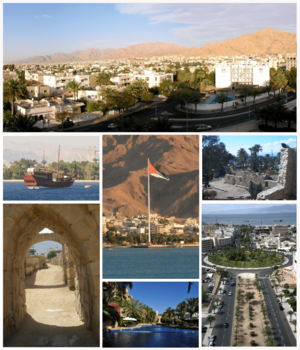
Clockwise from the left top: Aqaba's skyline, Aqaba Fort and Aqaba Fields, Al-Hammamat Al-Tunisyya Street in Down Town, Resort in Aqaba, Ayla old City, Aqaba Port, Aqaba Flagpole.
|
|
| Nickname(s):
The Bride of the Red Sea
|
|
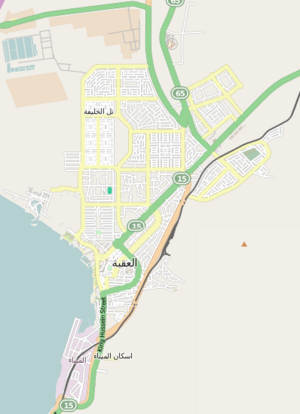 |
|
| Country | |
| Governorate | Aqaba Governorate |
| Founded | 4000 BC |
| Authority | 2001 |
| Area | |
| • City | 375 km2 (145 sq mi) |
| Elevation | 6 m (20 ft) |
| Population
(2021)
|
|
| • City | 95,048 |
| • Density | 502/km2 (1,300/sq mi) |
| • Urban | 148,398 |
| Demonym(s) | Aqabawi |
| Time zone | +2 Eastern European Standard Time |
| • Summer (DST) | +3 Arabia Standard Time |
| Postal code |
77110
|
| Area code(s) | +(962)3 |
Aqaba (English: /ˈækəbə/ ak-Ə-bə, US also /ˈɑːk-/ AHK--; Arabic: الْعَقَبَة, romanized: al-ʿAqaba, pronounced [ælˈʕæqɑba, ælˈʕæɡæba]) is Jordan's only city located on the coast. It is the largest city on the Gulf of Aqaba. Aqaba is in southern Jordan and is the main city of the Aqaba Governorate.
In 2015, about 148,398 people lived there. Aqaba is very important for Jordan's economy. It has busy trade and tourism industries. The Port of Aqaba also helps other countries in the region with their trade.
Aqaba's location at the top of the Red Sea has made its port important for thousands of years. It sits between the continents of Asia and Africa. The ancient city was called Elath, then Aela in Latin, and Ayla in Arabic. Its location and nearby copper mines made it a center for copper production long ago. The name Aqaba came much later. During the Great Arab Revolt, Arab forces won the Battle of Aqaba against the Ottoman Empire.
Aqaba is part of Jordan's "golden triangle of tourism" with Wadi Rum and Petra. This has made it a major tourist spot. The city is managed by the Aqaba Special Economic Zone Authority. This group has made Aqaba a low-tax, duty-free area. This has brought in big projects like Ayla Oasis and Saraya Aqaba. These projects aim to make Aqaba a top tourism hub. However, trade and industry are still key because it's Jordan's only seaport.
Contents
What's in a Name?
The city's old name was Elath or Ailath. This name probably came from a type of tree called Pistacia. The modern city of Eilat in Israel, which is close by, also gets its name from this ancient settlement.
Later, during the Hellenistic period, the Greeks called it Berenice. But the old name came back under Roman rule as Aila or Aela. The Crusaders, who were European knights, called the city Elyn.
The name al-ʿAqaba (العقبة) means "the mountain-pass of Ayla." This name was first used in the 12th century. It refers to a mountain pass just northeast of the city.
A Look Back in Time
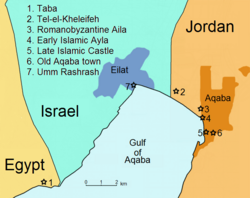
Ancient Settlements
Archaeologists have found old settlements near Aqaba. These sites, called Tall Hujayrat Al-Ghuzlan and Tall Al-Magass, date back to around 4000 BC. This was during the Chalcolithic period, also known as the Copper Age. People living there produced a lot of copper.
Archaeologists from the University of Jordan found a small building with drawings of humans and animals. This suggests it was a religious site. The people also had a good water system to water their crops like grapes, olives, and wheat. Many clay pots were found, showing that copper production was a big industry. These pots were used to melt and shape copper.
Early History of Aqaba
Elath: A Trading Hub
The Edomites, who lived south of the Dead Sea, are thought to have built the first port in Aqaba around 1500 BC. They called it Elath. With help from the Phoenicians, they became good at sea trade. Elath became a major center for trading copper. Its location, where trade routes between Asia and Africa met, made it very important.
Tell el-Kheleifeh
Another ancient settlement from the Iron Age was found at Tell el-Kheleifeh, just west of Aqaba. People lived there between the 8th and 4th centuries BCE.
Changing Rulers
Around 735 BC, the city was taken over by the Assyrian empire. Because of wars, trade routes shifted to Aqaba, making the port busy. The Babylonians conquered it in 600 BC. During this time, Elath grew a lot economically. The Persian Achaemenid Empire took the city in 539 BC.
Roman and Byzantine Times
Growing Importance
The city kept growing and became a major trading hub by 300 BC, under Greek rule. A Greek historian called it "one of the most important trading cities in the Arab World." The Ptolemaic Greeks named it Berenice.
The Nabatean kingdom had its capital, Petra, north of Aqaba.
Roman Rule
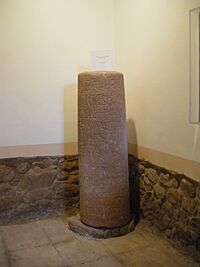
In 64 BC, the Romans took over the city and called it Aela. Aela reached its peak during Roman times. A major Roman road, the Via Traiana Nova, ended in Aela. This road connected it to other important cities. Around AD 106, Aela was one of the main ports for the Romans on the Red Sea.
Early Christian Era
The Aqaba Church was built by the Romans between 293 and 303 AD. It is thought to be the oldest church built specifically for Christian worship in the world. Aela became a Christian bishopric (an area led by a bishop) early on. Its bishop, Peter, was at the First Council of Nicaea in 325 AD.
One of the oldest texts written in the Arabic alphabet was found near Aqaba, dating to the late 4th century.
Early Muslim Period
Aila became part of the Islamic empire by 629 AD. The old city was left behind, and a new Arab city called Ayla (Arabic: آيلا) was built nearby.
Archaeologists have dug up the Early Muslim city. It was a strong, walled city with four gates. These gates led to two main roads that crossed in the center. The city grew rich from 661 to 750 AD under the Umayyads and later under the Abbasids and Fatimids. Ayla was a key stop on the trade route to India and for Arab spices. It was also mentioned in some stories from the Arabian Nights.
The city was a stop for Mecca-bound pilgrim caravans.
Crusader and Mamluk Periods
In 1115, Baldwin I of Jerusalem took over the city. The city center moved south along the coast. The Crusaders built the fortress of Elyn. This helped the Kingdom of Jerusalem control trade routes and protect their lands. They also built a fortress on Pharaoh's Island nearby.
However, not many Europeans settled in the area. The region was mostly home to Bedouins. In 1170, Saladin's forces captured the city. The Crusaders never took it back.
The old fort was rebuilt as Aqaba Fortress by the Mamluk sultan Al-Ashraf Qansuh Al-Ghuri in the early 1500s. For the next 400 years, Aqaba was a small fishing village.
Modern History
During World War I, T. E. Lawrence and Arab forces won the Battle of Aqaba in 1917. This forced the Ottoman forces to leave. Taking Aqaba allowed the British to send supplies to the Arab forces.
-
Lawrence of Arabia on a camel in Aqaba in 1917
In 1965, King Hussein of Jordan made a land deal with Saudi Arabia. Jordan gained 12 kilometers of coastline south of Aqaba, which included the beautiful Yamanieh coral reef. This was important for Aqaba's future.
In 1997, the Aqaba Marine Reserve was created to protect the sea life in the southern part of the Gulf of Aqaba.
Where is Aqaba?
The city is at Jordan's southernmost point, on the Gulf of Aqaba, which is part of the Red Sea. Its location is very important because it's at the meeting point of Asia and Africa. It shares borders with Israel, Egypt, and Saudi Arabia.
Weather in Aqaba
Aqaba has a hot desert climate. This means it has mild winters and very hot, dry summers. Sometimes, temperatures can drop below freezing in winter, but this is rare.
| Climate data for Aqaba | |||||||||||||
|---|---|---|---|---|---|---|---|---|---|---|---|---|---|
| Month | Jan | Feb | Mar | Apr | May | Jun | Jul | Aug | Sep | Oct | Nov | Dec | Year |
| Mean daily maximum °C (°F) | 20.5 (68.9) |
22.3 (72.1) |
25.9 (78.6) |
31.0 (87.8) |
35.3 (95.5) |
38.5 (101.3) |
40.0 (104.0) |
39.6 (103.3) |
36.7 (98.1) |
32.5 (90.5) |
27.0 (80.6) |
22.0 (71.6) |
30.9 (87.6) |
| Daily mean °C (°F) | 14.9 (58.8) |
16.4 (61.5) |
19.7 (67.5) |
24.3 (75.7) |
28.3 (82.9) |
31.3 (88.3) |
33.1 (91.6) |
33.0 (91.4) |
30.5 (86.9) |
26.6 (79.9) |
21.2 (70.2) |
16.4 (61.5) |
24.6 (76.3) |
| Mean daily minimum °C (°F) | 9.3 (48.7) |
10.5 (50.9) |
13.4 (56.1) |
17.6 (63.7) |
21.3 (70.3) |
24.0 (75.2) |
26.1 (79.0) |
26.3 (79.3) |
24.2 (75.6) |
20.6 (69.1) |
15.3 (59.5) |
10.8 (51.4) |
18.3 (64.9) |
| Average precipitation mm (inches) | 4.5 (0.18) |
3.7 (0.15) |
3.4 (0.13) |
1.8 (0.07) |
1.0 (0.04) |
0.0 (0.0) |
0.0 (0.0) |
0.0 (0.0) |
0.0 (0.0) |
3.0 (0.12) |
2.4 (0.09) |
4.9 (0.19) |
24.7 (0.97) |
| Average precipitation days | 2.0 | 1.4 | 1.5 | 0.8 | 0.5 | 0.0 | 0.0 | 0.0 | 0.0 | 0.6 | 0.9 | 1.9 | 9.6 |
| Source: Jordan Meteorological Department | |||||||||||||
Aqaba's Economy
Aqaba's economy relies on tourism and its port. Because it's a special economic zone, some businesses don't have to pay taxes. This has led to new resorts, homes, and shops being built. Projects like Tala Bay and Saraya al Aqaba offer fancy places to stay and live.
Aqaba's location near Wadi Rum and Petra makes it part of Jordan's "golden triangle of tourism." This has made it a major tourist spot. The Aqaba Special Economic Zone Authority manages the city. They have made Aqaba a low-tax, duty-free city. This has brought in big projects like Ayla Oasis, Saraya Aqaba, and Marsa Zayed. These projects are expected to make Aqaba a major tourism center. However, industrial and trade activities are still very important because Aqaba is Jordan's only seaport.
Since 2001, over $20 billion has been invested in Aqaba. Global shipping companies have also invested in logistics, making Aqaba a key transport hub. Many hotels are already in Aqaba, and more are being built.
As Jordan's only seaport, almost all of Jordan's exports leave from here. Large machinery factories are also growing in the city.
Tourism in Aqaba
Aqaba has many luxury hotels, including those in the Tala Bay resort. People come here to enjoy the beaches and go Scuba diving. Aqaba has over thirty main diving spots for all skill levels. These spots have coral reefs that stretch for more than 25 kilometers.
You can also do activities that use its desert location. Many coffee shops offer local dishes like mansaf and desserts like knafeh and baqlawa. A popular place is the Turkish Bath (Hamam), built in 306 AD, where people relax.
In 2006, the number of tourists visiting Aqaba grew to about 432,000. Most of them were Jordanians. Europeans were the largest group of foreign tourists. Aqaba was chosen as the Arab Tourism City of 2011.
During holidays like Eid, many Jordanians and visitors come to Aqaba. Hotels often get fully booked. New projects in Aqaba are also creating opportunities for local people.
Who Lives in Aqaba?
Aqaba's population has been growing quickly. In 2007, about 98,400 people lived there. By 2011, this number was estimated to be 136,200.
Religion in Aqaba
Most people in Aqaba are Muslim. However, there are also about 5,000 Christian families living in the city. There are several churches and Christian schools, like Rosary Sisters School Aqaba.
City Buildings
Most residential buildings in Aqaba are four stories high and made of sandstone or limestone. The city doesn't have many tall buildings yet. However, the Marsa Zayed project plans to build several high-rise towers. These will include hotels, homes, offices, and clinics.
Culture and Fun
Museums
The biggest museum in Aqaba is the Aqaba Archaeological Museum.
Nightlife
Aqaba's nightlife has grown a lot, especially with more tourists visiting in the 2000s.
Food in Aqaba
Because Aqaba is Jordan's only coastal city, it has its own special food. Main dishes include Sayadeyah, which is rice, fish, and spices. Kishnah is fish, tomatoes, and onions cooked together. Bukhari is made with rice, meat, and chickpeas, and is popular at weddings.
Aqabawi desserts include Al-Hooh, a pastry with nuts or dates, fried and dipped in sugar syrup. Dates and ghee (clarified butter) is a simple dessert often given to guests.
Getting Around Aqaba
Airports
King Hussein International Airport is the only civilian airport in Jordan outside of Amman. It's north of Aqaba and about a 20-minute drive from the city center. There are regular flights from Amman to Aqaba, which take about 45 minutes. Several international airlines also connect Aqaba to cities in Asia and Europe.
Roads
Aqaba is connected to nearby countries by a modern highway system. It's linked to the rest of Jordan by the Desert Highway and the King's Highway. You can travel to Eilat in Israel by taxi or bus through the Wadi Araba crossing. There are also many bus services between Aqaba and other major cities in Jordan.
Port
The Port of Aqaba is Jordan's only port. Ferries regularly travel to Taba in Egypt. These routes mainly serve Egyptian coastal cities like Taba and Sharm Al Sheikh. In 2006, the port was named the "Best Container Terminal" in the Middle East. This was because of its improvements and its ability to handle trade for Jordan and four neighboring countries.
Amazing Wildlife
The Gulf of Aqaba is full of marine life. It has about 500 types of fish. Many, like lion fish and octopus, live there all the time. Others, like sailfish (the fastest fish) and whale sharks (the largest fish), visit in the summer. Marine mammals and reptiles also live in the gulf during summer, such as hawksbill sea turtles and bottle-nosed dolphins.
Divers often see yellow-mouthed moray eels, blue spotted stingrays, eagle rays, Napoleon wrasse, frogfish, groupers, barracuda, and clownfish.
The Gulf of Aqaba is also home to over 390 bird species. These include migratory birds like the greater flamingo, great white pelican, and pink-backed pelican.
Learning in Aqaba
Here are some universities and colleges in Aqaba:
|
Sister Cities
Aqaba is connected to these cities around the world:
 Alcamo, Italy
Alcamo, Italy Basra, Iraq
Basra, Iraq Hammamet, Tunisia
Hammamet, Tunisia Saint Petersburg, Russia
Saint Petersburg, Russia Sharm El-Sheikh, Egypt
Sharm El-Sheikh, Egypt Ürümqi, China
Ürümqi, China
Images for kids
See also
 In Spanish: Áqaba para niños
In Spanish: Áqaba para niños


